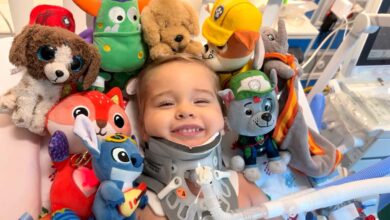Functional MRI provides ‘roadmap’ for surgery in previously inoperable areas of the brain

Adèle Noyer’s parents noticed the indentation in her chest as a baby. Both her father and grandfather had slight hollows, a condition called pectus excavatum, or “sunken chest syndrome,” where rib cartilage pushes the breastbone inward.
By third grade, Adèle struggled to keep up with friends and became easily breathless. Her pediatrician referred her to a surgeon at UCLA Health. The dip in her chest was measured annually, and by seventh grade, it had deepened 3 inches, reducing her stamina. In March 2024, 13-year-old Adèle underwent surgery at UCLA Mattel Children’s Hospital, where surgeons placed a custom-bent titanium bar beneath her sternum.
“The bar is custom-bent to the patient’s shape, and the correction is immediate,” said her pediatric general surgeon, Justin Wagner, MD. “But the remodeling of the chest shape is the process that takes a little bit longer. That’s why we’ll leave the bar in for three years to allow it to heal, scar and set. Then we’ll take the bar out at a second procedure.”
Chest wall abnormalities are fairly common, affecting 1 in 300 to 500 people, predominantly males. UCLA Health’s pectus program treats conditions in children and adults, from non-surgical interventions for mild defects to severe cases where the breastbone compresses the heart and lungs.
“Most people going through this have a fear that there’s no way the chest can look normal,” said pediatric general surgeon Veronica “Ronnie” Sullins, MD. “The majority of them are not dangerous. But, they also change over time. The ideal time to evaluate patients is during adolescence when the chest wall is changing quickly, but we care for patients from childhood to older adults.”
Pectus Pioneer
UCLA Health’s pectus program began in the 1960s with Eric Fonkalsrud, MD, an international authority on the management of chest wall deformities. “His teaching is so ingrained in pediatric surgery that it’s hard to come across somebody who hasn’t learned from him,” said Dr. Sullins, associate clinical professor of pediatric surgery at the David Geffen School of Medicine at UCLA.
Surgeons diagnose pectus excavatum through physical exams and imaging, such as X-rays or CT scans.
“The question always comes up about whether this is a functional problem or an aesthetic one, and there’s definitely a component of both,” said Dr. Wagner, assistant clinical professor of pediatric surgery at the David Geffen School of Medicine at UCLA. “The first consideration is the way a patient feels and the way it’s affecting their lives. If a patient says to me that they’re really unhappy, that they’re unable to keep up with their peers and have trouble breathing, these are major contributors to the decision to have surgery.”
Sunken chest syndrome is commonly treated with the minimally invasive Nuss procedure, which involves the insertion of a titanium bar. Surgeons use nerve cryoablation and Enhanced Recovery After Surgery (ERAS) protocols to reduce pain and opioid use, allowing next-day discharge.
“We’re correcting a defect that is formed over time,” said Dr. Sullins, “so suddenly moving the chest wall up, when it was down, can be kind of painful, especially with nerves coming around each rib. So we use a probe to freeze the nerves and make them numb for about three months.”
Adult Patients
Most pediatricians now recognize pectus excavatum early, but older generations may delay treatment until daily life is impacted. Leigh Dannhauser, 32, dismissed her chest divot as “weird cleavage” until declining endurance and heart palpitations interfered with daily activities.
Given Dannhauser’s family history of cardiac disease, cardiologist Megan Kamath, MD, referred her to thoracic surgery. Imaging showed her sternum compressing her heart and pushing it into her lung.
Because surgeons for adult and pediatric patients collaborate closely, Dannhauser saw both during her appointment. Dr. Sullins performed the Nuss procedure in July 2022.
“When it’s a very focal defect, we sometimes need two bars to get a good correction across the entire length of the sternum,” explained Dr. Sullins. “Like a seesaw, if you put a bar where it’s pointiest, then there might be some instability of that bar. We need to put in two bars so both of them can be stable.”
Dannhauser saw her smooth chest immediately after surgery, and the heart palpitations were gone. Recovery during the first month was difficult, she said, but she made it to the start of her final law school year. By graduation, she was doing CrossFit again — and even climbed Mt. Fuji.














